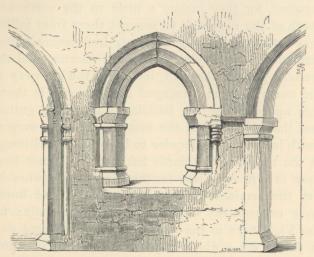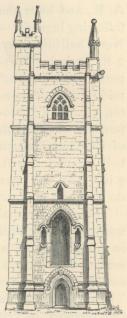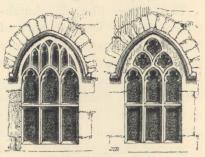The following description is lifted directly from [Blight 1885] but note that the text was prepared for the Gentleman’s Magazine 1862-64 and is largely unaltered. It must be read in the context of that date. The drawings are by the author.
ST. PAUL.—This church stands on the summit of a hill overlooking the fishing village of Mousehole, and is about three miles from Penzance. It possesses few architectural features of interest, for it is perhaps the most sadly disfigured church in the west of Cornwall. Some historical interest is, however, attached to the spot; for in the year 1595 the Spaniards paid a hostile visit to this parish, and, says Carew,—
“Burned not onely the houses they went by, but also the parish church of Paul, the force of the fire being such, as it vtterly ruined all the great stonie pillers thereof; others of them in that time burned that fisher towne Mowsehole; the rest marched as a gard for defence of these firers.”
In reference to this subject the parish register thus commences:—
“Jesu spes et Salus mea.
“1595.“A register of the names of all those that were baptised, married, and buried in the Parish Church of St. Pawle in the Countie of Cornwall, from the 23rd Daie Julie, the year of our Lord God 1595, on the which Daie the Church, towre, bells, and all other things pertaining to the same, together with the houses and goods, was Burn’d and spoil'd by the Spaniards in the said parish being Wensdaie the daie aforsaid, in the 37th yeare of the Reigne of our Sovereigne Ladie Elizabeth, by the grace of God, of England, Fraunce, and Ireland, defender of the Faith.
“Per me Johannem Tremearne, Vicarium Ejus.”
If the stonework of the tower was injured, it was evidently restored with the original materials; but the greater probability is, that only the woodwork was destroyed, which of course involved the destruction of the bells. The tower was erected perhaps about the end of the fifteenth century. There is a tradition in the parish to the effect that the Spaniards met some of the country people bearing fagots of furze, and driving them into the church compelled them to drop their bundles, to which they set fire; and as it happened to be a strong south- west wind, they opened wide the door to receive the benefit of its aid. When the porch was opened for repairs, in the year 1807, some of the woodwork was found to be charred. This fact supports other evidence that the church was not totally demolished. Nearly all the timber in it was probably consumed, and doubtless some portions of the walls suffered much; but Carew’s statement, that “all the great stonie pillers” were “vtterly ruined” requires some qualification, — for the present piers, though they might subsequently have undergone repair, were evidently constructed previous to the landing of the Spaniards. The arches appear to have been clumsily repaired, for they incline a little to the north and south of the nave, and to prevent them from falling they are connected by unseemly iron braces bolted through the spandrels. The south doorway and the western part of the wall, including the doorway of the north aisle, also escaped destruction. It therefore appears that the building was simply gutted, and that the walls at the eastern end only were so much injured as to require to be rebuilt. Although at the time the Spaniards left it, it could not have been in a fit condition for the usual public worship, yet the services of baptism, marriage, and burial were undoubtedly celebrated within the walls: for the Vicar says in the register, “From the 23rd daie of Julie,” &c.,—which implies that it was still possible to perform these necessary services within the church. The destruction by fire, in the year 1853, of the neighbouring parish church of St. Hilary, affords a melancholy instance of the amount of injury a building of like description would incur under similar circumstances. This church, however, probably received more damage than that of St. Paul, yet whilst it was still unroofed and blackened by the effects of fire a marriage was celebrated at its altar.

Arch between Nave and North Aisle, St. Paul.
The present church of St. Paul is of large dimensions. The nave and aisles are connected by nine four-centred arches, but the third arch westward from the chancel on the north side of the nave is of peculiar formation. As will be seen by reference to the accompanying cut it is very small, and is constructed on a solid block of masonry, which is 3 ft. 6 in. above the floor. This arch may have been in some way connected with the rood-loft and screen, or perhaps it was a hagioscope from the transept which the aisle replaced. It is of earlier date than any other part of the building except the tower.
The windows of the aisles are of churchwarden insertion, ugly and round-headed; and the east window is a perfect caricature. All have wooden frames with large panes of glass.

Tower, St. Paul.
The tower, like all church-towers in the western part of Cornwall, is constructed entirely of wrought granite. It is a fine building, divided into three stages, with double buttresses at the angles. The newel staircase, like that at St. Burian, is contained in a turret which rises above the embattled parapet. The mullions and tracery have been removed from the large tower-window, which is filled up in the most barbarous manner. Over this window and on either side is a niche, from which the ancient images have been removed. On the lower part of the niche on the left of the window is carved the letter M, which, of course, indicates that the image of the Blessed Virgin stood here; the niche on the other side has a blank shield. The hoodmoulding over the doorway springs from two corbel-heads, and at the centre of the mould is a shield bearing the sacred characters I. H. C. The belfry-lights retain their original tracery, which is very good of its kind. The tower-arch is of very excellent proportions; it is superior to those in most other churches in this district. The three bells are each dated 1727, with the initials A. R., and have the following legends:— North bell (diameter, 2 ft. 10 in.), “Prosperity to this parish;” middle bell (diameter, 3 ft. 3 in.), “Prosperity to the Church of England ;“ south bell (diameter, 3 ft. 3 in.), “To the church the living call: To the grave do summon all.”

Belfry Windows, St. Paul.
There is a mural monument, dated 1689, in the north aisle, to William Godolphin, of Trewarveneth, in this parish: he is said to have been the last representative of that ancient and noble family. Two swords and pieces of armour are hung over the stone. There is also a most elaborate monument here, to the memory of “Stephen Hutchens of this parish, who departed this life at Port Royall in Jamaica, the 24th day of August, 1709 :“—
“He hath given one hundred pounds towards the repairing and beautifying this church, and six hundred pounds for building a house for six poor men and six poor women born in this parish.”
We are also informed by a quotation from, or rather variation of, the 112th Psalm, that Stephen Hutchens “saw his desire upon his enemies.” The monument is in the most florid style: there are representations of shattered vessels, warlike instruments and trophies, with a profile likeness of Queen Anne. It is worthy of notice only because it bears an old Cornish inscription:—
“Bounas heb dueth Eu poes Karens wei
tha Pobi Bohodzhak Paull han Egles nei.”
Which has been rendered into English thus:—
“Eternal life be his whose loving care
Gave Paul an alms-house and the church repair.”
It was the custom at one time to place Cornish inscriptions in churches, but this appears to be the only one now remaining.
Particular interest is attached to this church on account of its being the burial-place of Dolly Pentreath, said to have been the last person able to converse in the old Cornish language. A well-cut granite obelisk has lately been erected here in commemoration of this tradition. The monument is inscribed with the name of Dorothy Pentreath, which was the maiden name of the old woman, for it appears that she was married to a person of the name of Jeffery. This, however, is of no great importance, for she is popularly known as Dolly Pentreath, and it is still the custom in the villages of Mousehole and Newlyn for women to be called by their maiden names after marriage; indeed, there are some instances in which the husband goes by the maiden name of his wife, she being the more popular or more important personage of the two.
This church was attached to the mitred abbey of Hailes, in Gloucestershire, and is dedicated to St. Paulinus, first Archbishop of York, who was sent into England by Pope Gregory soon after the mission of St. Augustine. In the Taxation of Pope Nicholas, AD. 1291, it is entered as “Ecclesia Sancti Paulini.”
Should any reader of this paper visit the church of St. Paul let him not forget to ascend to the roof of the tower: the magnificent view from the summit is well worthy of the labour.
[The book continues with Sancreed.]